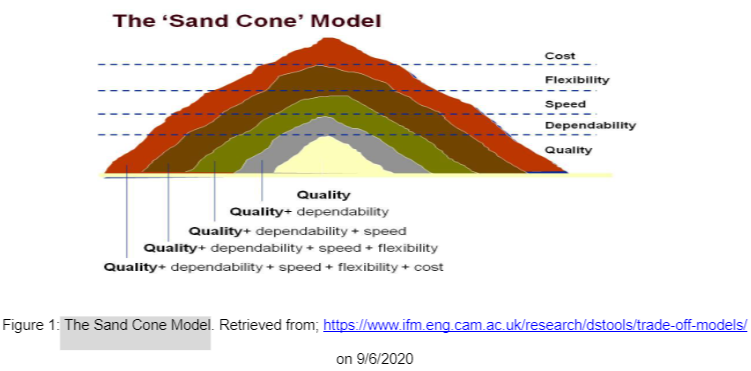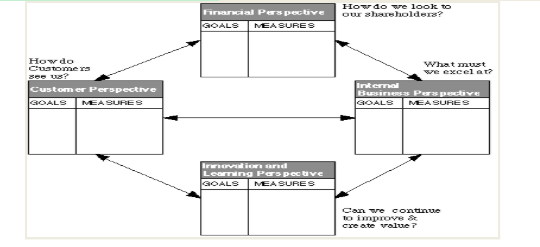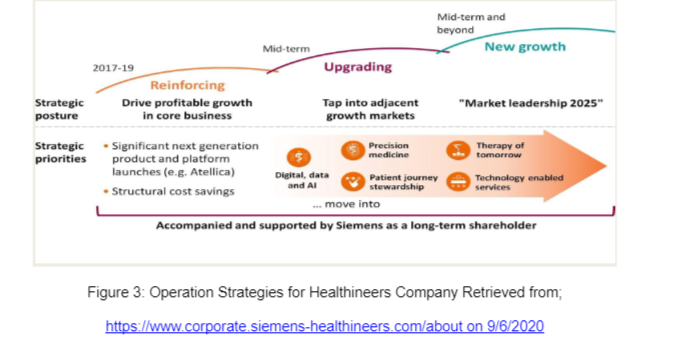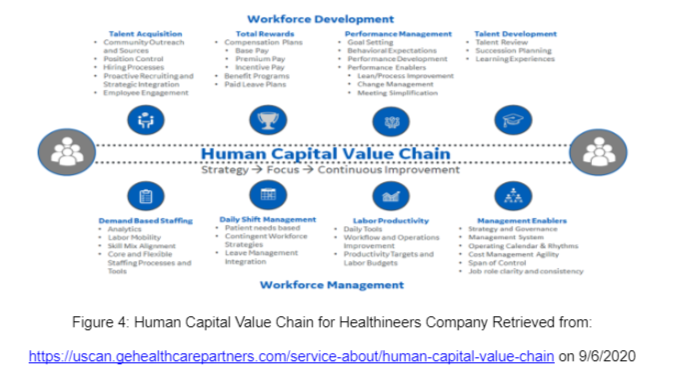International Operations Management
- 12 Pages
- Published On: 31-05-2024
Key Decision Areas in Operations Strategy
GE Healthcare is one of the global market leaders in medical technology and digital solutions innovation. The company’s Edison Intelligence platform is a crucial pillar spearheading these pursuits. GE Healthcare’s strategic priorities lie in expanding its profit margins by focusing on its design productivity. The aim here is to focus on material costs and lower procurement costs of necessary materials, but also lower costs in the entire manufacturing and assembling procedures (Hayhurst, 2019). For students working on healthcare-related topics, healthcare dissertation help can be invaluable in navigating the complexities of this field. For students needing healthcare dissertation help, this approach can serve as an insightful case study on cost management and technological advancements in the healthcare industry.
One of the key organisational decision areas is market expansion. Amidst the growing demand for healthcare in emerging economies, GE Healthcare's decisions are founded on the threshold of how to meet the existing demand for healthcare. GE Healthcare is inspired by growth from the jurisdiction of emerging economies and gains from profits and cost cutbacks, which have all fuelled the company’s grasp in the market space. Over the last decade, GE Healthcare’s profits increased at the rate of 4.3%. Between 2011 and 2013, for instance, the profits compounded yearly growth rate of 4.3%, and the company maintained this trend in the following years (Linton, Klassen and Jayaraman, 2017). GE Healthcare offers medical imaging systems, patient monitoring systems, diagnostics, medical equipment repair services, drug discovery tools, and IT solutions in the global market sphere. By prioritizing the expansion of the company’s footprint in emerging markets (especially Asia and Latin America), the company has benefitted, especially considering healthcare is a primary need.

Another key decision area for GE Healthcare is research and innovation, which has led the company to expand and retain its competitiveness in the market. Creativity and innovation are major drivers of the company’s competitive strength. Also, focus is granted to cost reductions through processes such as headcount reduction and exits from geographic locations that attract low profits (Lee and Billington, 2015). Many companies tend to minimize production costs while maximizing profits. As an example, the company, under such initiatives, reduced the number of zones in the US, which consequently brought forth margin expansion.
GE Healthcare is of the view that the medical equipment market is fuelled by innovation. Imaging machines and other machines that provide high-resolution images and more accurate monitoring in hospitals by doctors are contemporary trends reorienting the contemporary healthcare market space. The company’s decisions are centred on this domain (Shepherd et al., 2016).
Besides, the company’s organisational decision area is on matching its technology developments with the dynamic consumers’ needs. The newly conceived products aim at ensuring they meet the users’ needs. In the contemporary world, value-based segmentation is critical in meeting the needs of diverse healthcare consumers. Focusing on world-class imaging is one of the key decision areas for GE Healthcare.
The company’s aim is to retain its market position as a global leader (Lakhani et al., 2013). This quest is driving the company to produce products and services that are attractive and responsive to global consumers. Also, the company is aligning its operations with the MOH priorities while accelerating its growth rates to meet market demand. Lastly, the company’s decision focuses on expanding life sciences. The aim is to provide critical solutions for biopharmaceutical corporations and retain the top pedestal as a leading company in the domain of cell therapy.
Benchmarking Against Strategic Group
GE Healthcare uses the operations strategy matrix to draw useful strategic decisions informing the company’s supply chain network, applicable technology, and corporate development. The decisions informed by the operations strategy matrix are constructed on the threshold of speed, quality, flexibility, reliability (dependability), and cost efficiency (Kwon, Kim, and Martin, 2016).
Besides, the Sand Cone framework maintains that although in the short run it is viable to trade off capabilities one against the other, there is a hierarchy amongst the four capabilities. In the quest for GE Healthcare to construct lifelong manufacturing potentials, resources and management decisions should reflect on achieving quality. Quality is then protracted to ensure dependability of the production system; next focus is later given to enhance production flexibility and lastly to cost-effectiveness (Kaplan and Norton, 1996).

The operation strategy matrix can be harnessed by GE Healthcare’s strategy professionals to evaluate the fundamental factors impacting its operations. The tool is important because it forms the basis under which the company can make informed strategic operation decisions aiming at reducing risks. The tool extracts attention from the success factors and implementation step proposals (Donohoe, and Robinson, 2010).
Mindray and Siemens Healthineers are the major rivals of GE Healthcare. Mindray is a medical tools manufacturer, producing and selling medical equipment, devices, and accessories for human and veterinary consumption. On the other hand, Siemens Healthineers produces and offers clinical diagnostics and therapeutic systems (Slack and Brandon-Jones, 2018).
2.1.1: Operational Strategies for GE Healthcare
The operations strategy aims to offer an excellent rubric on how the company will utilise its resources effectively. The strategy gives corporate entities a framework on how to use existing resources to support a long-term competitive strategy. The first operational strategy concern for GE Healthcare is Communication. Without a responsive communication strategy, the company may fail to coordinate its internal processes even when other operational strategies are vibrant. The company may not bear good results if the company’s internal stakeholders are unaware of the company’s approach. GE Healthcare aims to ensure smooth communication and cooperation amongst various departments to execute its strategy correctly. Communicating the strategy is not enough; the staff ought to comprehend the details, and this can be enhanced through staff meetings and open discussions on the strategy.
Besides, GE Healthcare is engaged in the continuous development of new products and services to enrich market consumers. To remain relevant and competitive, the company ought to develop new services and technologies in the health domain. GE Healthcare is aware that the healthcare market domain is dynamic as people’s preferences change. Mobilising resources towards creativity and innovation will thus retain the company’s grasp in the market.
In the quest to optimise its supply chain, GE Healthcare is harnessing strategic alliances to attain a competitive advantage. The company has collaborated with its rivals to improve market accessibility, functionality, and integrity.
Through collaborations, GE Healthcare has reduced or eliminated threats in the market while improving its capabilities and internal resources. An example is the partnership with Intel in 2011 to produce cost-effective products for family care (Ghosh and GE Healthcare UK Ltd, 2018). On product development, GE Healthcare enjoys technical leadership that yields high-margin products, and which inspires new markets (Mintz and Stoller, 2017). The company also focuses on need-specific products thus ensuring the products target the users directly.
The balanced scorecard below guides corporate managers to look at the business from four fundamental perspectives shown below. The model connects performance metrics by requiring the company to address four fundamental questions including (Kaplan and Norton, 2007):
- How do customers perceive us? (Customer perspective)
- What must we be excellent in? (Internal perspective)
- Can we keep up and produce value? (Learning and innovation perspective)
- How do we look in the lens of shareholders? (Financial perspective)

The following table compares GE Healthcare, Siemens Healthineers and Mindray Company based on OS matrix
2.1.2: Operational Strategies for Siemens Healthineers
The following pictorial presentation provides an overview summary of Healthineers operational strategies. The company focuses capturing short-term potentials and ensure it grasp the market leadership position after 2025.

2.1.3: Operational Strategies for Mindray Company
Mindray is one of the leading global providers of medical devices plus a broad range of medical imaging machines. The company is headquartered in Shenzhen, China. The following are the main operational strategies for Mindray:
- Complement the current product line offering
- Acquire distribution and sales channels in global market
- Strengthen its R&D potentials vertically (the company acquired the US Company, Zonare owing to its high-end ultrasound technology)
- To grasp expansion opportunities in domains near to Mindray for example orthopaedics
3: Supply Network Strategy
The effective utilisation on supply chain tools lowers GE Healthcare’s operational costs without compromising on quality products and services. The structure and quality of supply chain constitute significant influence in the market domain. Consumers will tend to look at GE Healthcare’s supply chains to inform adoption and consumption of its services and products, primarily to ensure sustainability metrics are achieved in the entire production process. Healthcare supply chain constitutes the flow of various products and the involvement of multiple stakeholders. The core aim of the healthcare supply chain is to offer products and services in a timely way to meet end-user needs.
In GE Healthcare, the company mainly focuses on continuous supply of products and services to meet the existing demand. The company’s new Wisconsin facility was built to oversee warranty management and form a strategic point of repairing the company’s equipment (Ross, Webb and Rahman, 2019). The motivation was to ensure continuous renovation of the company’s assets for continued production. The following figure manifests GE Healthcare’s human capital value chain.

From the above figure, GE Healthcare places more emphasis on two fundamental domains, namely; workforce development and workforce management. Consequently, the company prioritises not only in the development (through training) of the internal workforce but also external workforce, including those in the realm of the supply chain. Employee development results in increased quality in service delivery.
Supply chain strategies for GE Healthcare aims at maintaining a positive relationship with the consumers and suppliers (Mathew, John and Kumar, 2013). The positive relationship ensures the company becomes more innovative and efficient. The major focus is placed upon how the relationships connect the company in a supply chain and networks. GE Healthcare maintains a view that that quality supply chain is essential in improving operational effectiveness while enhancing responsiveness to customers. Thus, the company’s seeks to harness strategies that upscale the company’s capacity to operate within acceptable metrics that are conducive to both market consumers, current economic structures and the environment (Bolene et al., 2017).
Continue your exploration of Exploring the Operations Management of Inditex with our related content.

Continue your exploration of International Marketing, Innovation and e-commerce with our related content.
Bibliography
Bolene, D., Bolinger, E., Drees, M. and Fornarola, J., GLOBAL HEALTHCARE EXCHANGE LLC, 2017. Systems and methods for supply chain management. U.S. Patent 9,633,325.
Donohoe, M. and Robinson, C., 2010. GE Healthcare-" Most Admired Company" or Foe of Public Health. Social Medicine, 5(4), pp.237-244.
Ghosh, P., GE Healthcare UK Ltd, 2018. Display screen with a graphical user interface. U.S. Patent Application 29/575,396.
Hayhurst, C., 2019. Bright Ideas: Taking a ‘Lean’Approach to Healthcare Technology Management. Biomedical instrumentation & technology, 53(5), pp.374-377.
Kaplan, R.S. and Norton, D.P., 1996. Using the balanced scorecard as a strategic management system.
Kaplan, R.S. and Norton, D.P., 2007. Balanced scorecard. In Das Summa Summarum des Management (pp. 137-148). Gabler.
Kwon, I.W.G., Kim, S.H. and Martin, D.G., 2016. Healthcare supply chain management; strategic areas for quality and financial improvement. Technological Forecasting and Social Change, 113, pp.422-428.
Lakhani, K.R., Hutter, K., Pokrywa, S.H. and Fuller, J., 2013. Open innovation at Siemens. Harvard Business School Case 613, 100.
Mintz, L.J. and Stoller, J.K., 2017. 17 Leadership Skills for Global Health Care Innovators. Global Health Informatics: Principles of EHealth and MHealth to Improve Quality of Care, p.203.
Lee, H.L. and Billington, C., 2013. Material management in decentralized supply chains. Operations research, 41(5), pp.835-847.
Linton, J.D., Klassen, R. and Jayaraman, V., 2017. Sustainable supply chains: An introduction. Journal of operations management, 25(6), pp.1075-1082.
Mathew, J., John, J. and Kumar, S., 2013, May. New trends in healthcare supply chain. In Annals of POMS Conference Proceedings; Denver (pp. 1-10).
Ross, J., Webb, C. and Rahman, F., 2019. Artificial intelligence in healthcare. London: Academy of Medical Royal Colleges.
Shepherd, J.A., Fan, B., Lu, Y., Wu, X.P., Wacker, W.K., Ergun, D.L. and Levine, M.A., 2016. A multinational study to develop universal standardization of whole‐body bone density and composition using GE Healthcare Lunar and Hologic DXA systems. Journal of Bone and Mineral Research, 27(10), pp.2208-2216.
Slack, N. and Brandon-Jones, A., 2018. Operations and process management: principles and practice for strategic impact. Pearson UK.
- 24/7 Customer Support
- 100% Customer Satisfaction
- No Privacy Violation
- Quick Services
- Subject Experts



